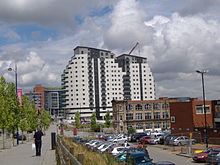
The Bull Ring is a major shopping area in central Birmingham England, and has been an important feature of Birmingham since the Middle Ages, when its market was first held. Two shopping centres have been built in the area; in the 1960s, and then in 2003; the latter is styled as one word, Bullring. When coupled with Grand Central it forms the United Kingdom's largest city centre based shopping centre, styled as Bullring & Grand Central.
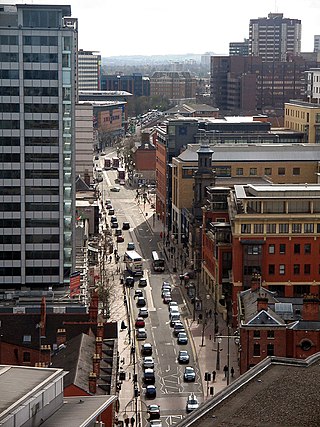
Broad Street is a major thoroughfare and popular nightspot centre in Central Birmingham, England. Traditionally, Broad Street was considered to be outside Birmingham City Centre, but as the city centre expanded with the removal of the Inner Ring Road, Broad Street has been incorporated into the new Westside district of the city centre due to its position within the A4540 road.

Birmingham Central Library was the main public library in Birmingham, England, from 1974 until 2013, replacing a library opened in 1865 and rebuilt in 1882. For a time the largest non-national library in Europe, it closed on 29 June 2013 and was replaced by the Library of Birmingham. The building was demolished in 2016, after 41 years, as part of the redevelopment of Paradise Circus by Argent Group. Designed by architect John Madin in the brutalist style, the library was part of an ambitious development project by Birmingham City Council to create a civic centre on its new Inner Ring Road system; however, for economic reasons significant parts of the master plan were not completed, and quality was reduced on materials as an economic measure. Two previous libraries occupied the adjacent site before Madin's library opened in 1974. The previous library, designed by John Henry Chamberlain, opened in 1883 and featured a tall clerestoried reading room. It was demolished in 1974 after the new library had opened.

Although Birmingham in England has existed as a settlement for over a thousand years, today's city is overwhelmingly a product of the 18th, 19th, and 20th centuries, with little surviving from its early history. As it has expanded, it has acquired a variety of architectural styles. Buildings of most modern architectural styles in the United Kingdom are located in Birmingham. In recent years, Birmingham was one of the first cities to exhibit the blobitecture style with the construction of the Selfridges store at the Bullring Shopping Centre.

The Big City Plan is a major development plan for the city centre of Birmingham, England.

McLaren is a 69-metre, 21 storey tall office building in Birmingham, England. It was designed by Paul Bonham Associates and built in 1972. It is situated by the Masshouse and Martineau Galleries redevelopment sites. The entrance is on Priory Queensway.

The Jewellery Quarter is an area of central Birmingham, England, in the north-western area of Birmingham City Centre, with a population of 19,000 in a 1.07-square-kilometre (264-acre) area.
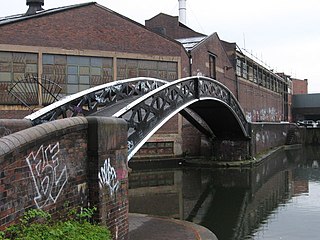
Bordesley is an area of Birmingham, England, 1.2 miles (2 km) south east of the city centre straddling the Watery Lane Middleway ring road. It should not be confused with nearby Bordesley Green. Commercial premises dominate to the west of the ring road, but much of this area is to be redeveloped. Blocks of residential apartments are planned and set for completion from the mid-2020s onwards. The largely residential area east of the ring road was renamed Bordesley Village following large scale clearance of back-to-back houses and redevelopment in the 1980s and 90s. Bordesley is the real life setting of the BBC series Peaky Blinders, and home to Birmingham City Football Club's ground, St Andrew's.

Queensway is the name of a number of roads in central Birmingham, England, but most often refers to the Queensway tunnel, part of the A38. Queensway is the suffix of several other roads and circuses, such as Smallbrook Queensway and Colmore Circus Queensway; all of which were once part of the historic A4400 Inner Ring Road, often called collectively the Queensway.
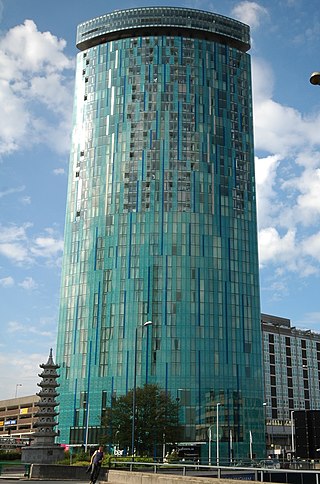
10 Holloway Circus is a 400-foot (122 m) tall mixed-use skyscraper in Birmingham city centre, England. It was originally named after the developers, Beetham Organisation, and was designed by Ian Simpson and built by Laing O'Rourke. The entire development covers an area of 7,000 square feet (650 m2). It is the second tallest building in Birmingham and the 74th tallest building in the United Kingdom.

Eastside is a district of Birmingham City Centre, England that is undergoing a major redevelopment project. The overall cost when completed is expected to be £6–8 billion over ten years which will result in the creation of 12,000 jobs. 8,000 jobs are expected to be created during the construction period. It is part of the larger Big City Plan project.
Martineau Galleries is a proposed mixed-use development for Birmingham, England which was shelved in 2009 but re-approved in 2020. It was to connect the Eastside to the city centre core, a major retail area.

Curzon Gate was a residential development located on the edge of Birmingham City Centre, West Midlands, England, on a prominent gateway site into the city centre. The land was formerly occupied by Castle Cement silos. The 4-acre (1.6 ha) site was located in the Eastside area, which is currently witnessing a large-scale regeneration scheme. It was located next to Curzon Park and opposite Eastside Locks, both of which are developments. It was bounded by a railway viaduct to the south and a road junction on the A4540 road. It was separated from Curzon Park by the Digbeth Branch Canal.
Springfield is an area of Wolverhampton, England immediately north east of the city centre. It was the home of the Springfield Brewery from 1873 until 1991. The brewery site has been redeveloped by The University of Wolverhampton for its architecture and built environment 'super-campus', which includes the National Brownfield Institute. There are modern student residential blocks, one of which is the tallest structure in Wolverhampton. For local government, Springfield is within the ward of Heath Town.
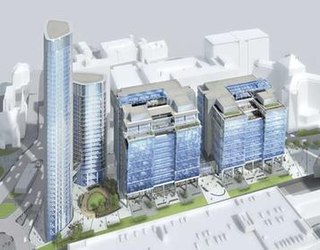
Snowhill is a mixed-use development in the Colmore business district, known historically as Snow Hill, in Central Birmingham, England. The area, between Snow Hill Queensway and Birmingham Snow Hill station, is being redeveloped by the Ballymore Group. The £500 million phased scheme has been partly completed on the site of a former surface car park adjacent to the railway station and West Midlands Metro terminus.

Birmingham city centre, also known as Central Birmingham, is the central business district of Birmingham, England. The area was historically in Warwickshire. Following the removal of the Inner Ring Road, the city centre is now defined as being the area within the Middle Ring Road. The city centre is undergoing massive redevelopment with the Big City Plan, which means there are now nine emerging districts and the city centre is approximately five times bigger.

Island House was a locally listed building in Birmingham's Eastside area, with a roughly triangular footprint. It was built in 1912 by the architect G. E. Pepper, in the Edwardian Mannerist style, ornately decorated with both Ionic and Doric decorations. Originally it was designed to be used as office building and warehouse for the prominent “Messrs Churchill & Co” machine tool company. The opening ceremony of Island House was held in 1913.

Paradise, formerly named Paradise Circus, is the name given to an area of approximately 7 hectares in Birmingham city centre between Chamberlain and Centenary Squares. The area has been part of the civic centre of Birmingham, England since the 19th century when it contained buildings such as the Town Hall, Mason Science College, Birmingham and Midland Institute buildings and Central Library. The site was redeveloped from 1960 to 1975 into the present Paradise Circus based within a roundabout on the Inner Ring Road system containing a new Central Library and School of Music. From 2015, Argent Group will redevelop the area into new mixed use buildings and public squares.

1 Lancaster Circus is a former municipal facility in Birmingham, England. It was the headquarters of West Midlands County Council from its formation in 1974 until its abolition in 1986. The building then served as offices of Birmingham City Council until 2022, when it was closed and sold.
